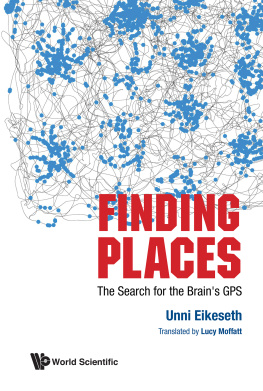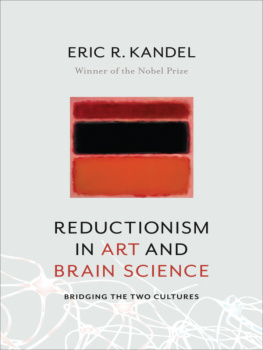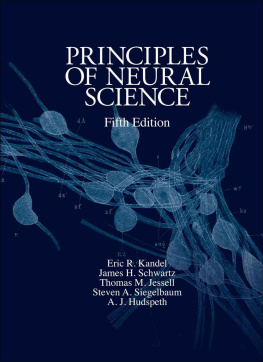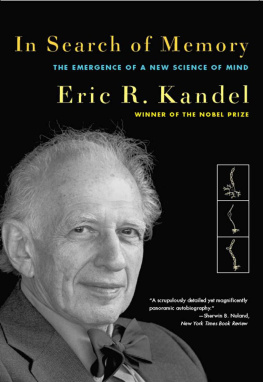Explorers of the Black Box
The Search for the Cellular Basis of Memory
Susan Allport
Contents
To David
I sometimes marvel how truth progresses, so difficult is it for one man to convince another, unless his mind is vacant.
Charles Darwin, letter to Alfred Russel Wallace
I went the other evening to the Zoological Society, where the speakers were snarling at each other in a manner anything but like that of gentlemen.
Charles Darwin, letter to John Henslow
EXPLORERS OF THE BLACK BOX
Prologue
One of the central questions in the study of nervous systems today is how the small number of brain genes in an animals DNA contrive to make a brain, to produce millions or billions of nerve cells connected to one another in a very precise fashion. There cant be a gene for every cell in a nervous systemlet alone for every twist of a dendrite or synapseso the question is how so much diversity and specificity can arise out of so little.
At least part of the answer to this question must lie in the properties of growth cones, specialized structures at the tip of a nerve cells axon that allow an axon to grow, to sample its environment, and to seek out other nerve cells with which to interact. These growth cones are expanded regions on an axon. They have special, undulating membranes that extend themselves into highly mobile, fingerlike extensions that explore and even taste the environment. They ingest material from the outside and send it up to the cell body of the neuron to be analyzed. When the results come back, the growth cone might be told, Move ten degrees to the right, or Do not interact with any axons in this vicinity. Growth cones are also the sites where most of the new material is added to a growing axon, and when an axon branches, it almost always does so by the formation of a new growth cone.
In 1963, a young psychiatrist named Eric Kandel, it can now be said, started a new growth cone along the axon representing the study of the brain when he had the insight to realize that an animal with a very simple nervous system could be used in experiments to address previously unapproachable questions about the cellular basis of such higher brain functions as learning and memoryto explore, as it were, the black box of the mind. Since then, that growth cone has continued to enlarge, to reach out and synapse with other disciplinesmolecular biology, biochemistry, neuroanatomy, and psychologyand to absorb from its environment information about the protein channels, second-messenger systems, and so on. Nobody knows exactly where it will go from here, but just as the study of one growth cone on one nerve cell can tell you a lot about how an entire brain is made, the study of one growing field of neurobiology can tell you a lot about the nature of science, much about nerve cells, and at least a little bit about the content of the brains of the scientists who study brains.
ONE
The Sea Hare and the Scientist
A convention of neuroscientists is in many ways much like any other convention. There is perhaps a greater percentage of men, certainly more beards, and probably more casual dressmore blue jeans and shorts and fewer suits. But since neuroscientiststhose scientists who study the brains of earthworms, humans, and everything in betweentake great pleasure in uninterrupted shoptalk, the hall in which a meeting of brain scientists is held, like any room full of people who spend their days pursuing a common goal and engaged in similiar activities, is filled with the very loud, almost mechanical-in-its-constancy hum of many people talking at once.
Like any other group of professionals, neuroscientists have their own jargon. Their conversations are so full of technical terms and familiar wordsspikes, fire, driveto which they have assigned strange new meanings that its easy to lose sight of the fact that they are about brainsabout those tangles of billions of nerve cells that are the seat of all imagining, all emotions, all behavior, all curiosity about the nature of brains. Most of us have spent some time wondering how our brain works. Brain scientists spend their entire lives pondering it, looking for a way even to begin asking the question, How does the brain generate mind? The brain, after all, is so complex an organ and can be approached from so many different directions using so many different techniques and experimental animals that studying it is a little like entering a blizzard, the Casbah, a dense forest. Its easy enough to find a way inan interesting phenomenon to studybut also very easy to get lost. Many intelligent men and women have gotten lost; theyve spent a lifetime accumulating data and constructing theories that may have seemed extremely important in their time but that were soon forgotten, disproved or reinterpreted, swept into the pile of discarded hypotheses and data founded on erroneous assumptionsa pile that in the history of neuroscience is particularly large.
Brain scientists, a Canadian researcher once told me, are like the proverbial group of blind men trying to describe the elephant. The difference between the scientists and the blind men is that the scientists have so much moreentire careers and reputations, decades of their livesinvested in their particular view of the elephant, in their idea of which of the myriad phenomena of the brain they should study and how they should go about it. With few exceptions, the types of experiments neuroscientists perform demand what one has called an impossible measure of patience. Every step of an experiment has an extremely high rate of failure; whatever story emerges from a laboratory does so very, very slowly.
As long as the brain is a mystery, Ramn y Cajal, the great Spanish neuroanatomist, wrote at the turn of the century, the universe, the reflection of the brain, will also be a mystery. Eighty years later, remarkable advances in brain research have yielded treatments and diagnostic techniques for a number of the brains diseases, as well as a fairly good understanding of how a few of the structures of the brain are wired together, how a nerve cell transmits an electrical impulse, and how sensory information is first processed. The brain as a whole, though, is still fundamentally a mystery. Some neurobiologists hope that it will always remain one and that science (despite their own efforts to the contrary) will not cross what is often called the last frontier of understanding. But if an understanding of the brain contines to elude scientists, it will not be for want of trying.
The magnitude of the current attempt to understand the brain is nowhere more evident than at the annual meetings of the Society for Neuroscience, an organization with over 10,000 members from many different disciplines who share an interest in nerve cells and brains. At the 1984 meeting, held at the convention center in Anaheim, California, over 7,210 participants gathered to deliver or listen to more than 4,710 different presentations over a period of five days. Just the abstracts from the meetings formed two volumes about the size of the Manhattan telephone directory. On any given morning or afternoon, a convention goer has to choose from among over 40 sessions taking place simultaneously, each of which includes 12 to 26 short presentations. At any single moment, a physicist might describe the membrane biophysics of a particular type of nerve cell, while elsewhere a psychologist discusses the specific memory defect in a patient with alcoholism-related amnesia, a biochemist tells of the properties of a newly discovered neurotransmitter, a physiological psychologist talks about how information coming in through an animals chemosensory receptors is processed by the brain, a pharmacologist presents data on the binding properties of an inhibitor of synaptic transmission, an invertebrate neurophysiologist explains the neural circuit that controls swimming in the leech, a developmental neurobiologist describes factors that enhance nerve cell growth, an anatomist reports on the migration patterns of neurons in the visual cortex during the embryonic development of rats, and so on and so on, multiplied many times over for five days.











